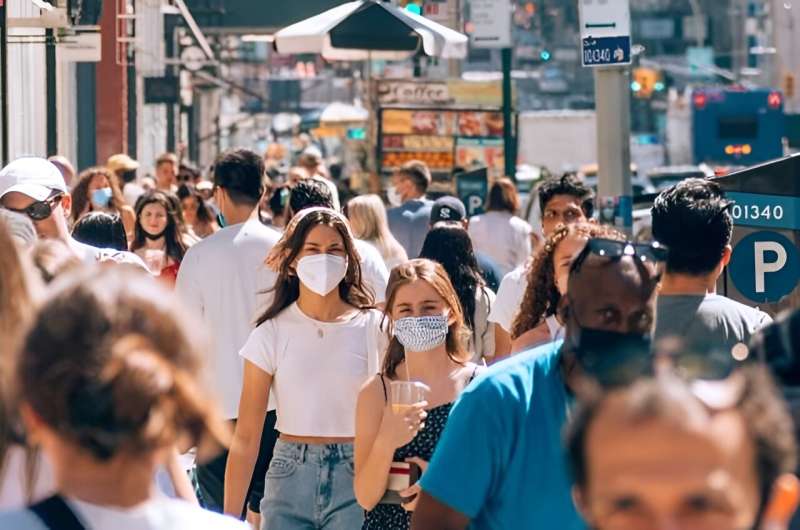This article has been reviewed according to Science X's editorial process and policies. Editors have highlighted the following attributes while ensuring the content's credibility:
fact-checked
trusted source
proofread
The ethical dilemmas of preventing the next pandemic

Could protecting one group of people from disease, and exposing another to it, be the best way to prevent as many deaths as possible and reduce the impact of a future pandemic? A study led by some La Trobe academics says yes, but the ethical dilemmas it raises might not be worth it.
Disease modelers have determined an effective way to reduce the impact of infectious diseases like COVID-19—but the results are likely to pose an ethical dilemma for decision- and policymakers.
The study, led by Dr. Joel Miller, associate professor of mathematics and statistics at La Trobe University, found that locking down the most at-risk group of people for a significant period, while simultaneously promoting infection in other groups in order to reach herd immunity, could be the best way to protect the high-risk groups.
However, increasing the exposure of one group to a disease would create an ethical dilemma and potentially result in the most disadvantaged groups in the community—usually with the least political power—becoming the highly-infected group.
"With COVID-19, the elderly were at high risk, so if we were to isolate them for a period of time, during which we enact policies that would cause younger age groups to interact more (not less), then the disease likely would not spread well once the isolations were lifted and interactions returned to normal," Dr. Miller said.
"If we set aside the question of whether such a strategy is logistically feasible, in a sense this is an optimal intervention. However, there are major ethical challenges that result—the intervention makes younger age groups worse off from an infection point of view.
"Our goal in this paper is not to advocate for such a policy, but rather to highlight some ethical dilemmas that emerge from intervention strategies. It is important that policy makers recognize the trade-offs that an 'optimal' strategy might require."
The paper, "Ethical dilemma arises from optimising interventions for epidemics in heterogeneous populations," has been published in the Journal of The Royal Society Interface and includes co-authors from La Trobe University, University of Melbourne and Northeastern University London.
The researchers used "SIR and SIR-like models" which assume individuals in the population are Susceptible, Infected, or Recovered (with immunity) to study the optimal intervention, such as lockdowns and isolation, required in a community to reduce and delay the peak of an epidemic, and ensure there is no further risk of a future epidemic or second wave of infections. They explored what would happen if different groups within the population, such as different age groups, have different risk factors for severe infection.
Using data from a Netherlands survey that determined how often people in different age groups came into contact with each other, the researchers simulated different scenarios to determine the best outcome for an entire population, assuming that an intervention altering the contacts would be in place for a limited time.
It found that if the intervention did not reduce contacts sufficiently then a large epidemic would occur. However, if the intervention reduced contacts too much there would be a modest epidemic and once the intervention was lifted, many individuals would still be susceptible, and a second wave would occur.
The optimal intervention occurs where contacts are reduced so that the initial epidemic is as small as possible while still infecting enough people to prevent a second wave.
If there are multiple groups with varying risk, the same general principles apply, but sometimes the optimal intervention increased the number of infections in the lower-risk groups to reduce the risk of a second wave once the intervention would end.
"This calls for a discussion around the ethics of subjecting certain groups to a higher rate of disease incidence, and the feasibility of this policy," the study says.
Dr. Miller said this was the first study to consider the ethical implications of an increase in infections as a strategy for optimal outcomes, without the use of vaccines.
However, Dr. Miller says choosing which groups to lockdown, and those in which to actively promote infection, was an ethical dilemma for governments and the community.
"Mathematical models of epidemics can throw light on possible choices of policy and may even help us pick the ones that lead to optimal outcomes. But the decisions made by policymakers are intertwined with political will, their popularity, and social attitudes," the study says.
"These eventually determine whether a particular intervention is favored by a decision-making body."
"Disadvantaged groups, across the world, do not exercise sufficient political power to represent their interests in decision-making bodies. In such a case, a decision-making body may find it convenient to subject a disadvantaged group to a higher final size in order to decrease the net final size for the whole population and achieve herd immunity."
"The intervention strategy presented here, always carries such risks with it; and representation of disadvantaged groups thus becomes essential, especially for a policy such as this one."
More information: Pratyush K. Kollepara et al, Ethical dilemma arises from optimizing interventions for epidemics in heterogeneous populations, Journal of The Royal Society Interface (2024). DOI: 10.1098/rsif.2023.0612





















